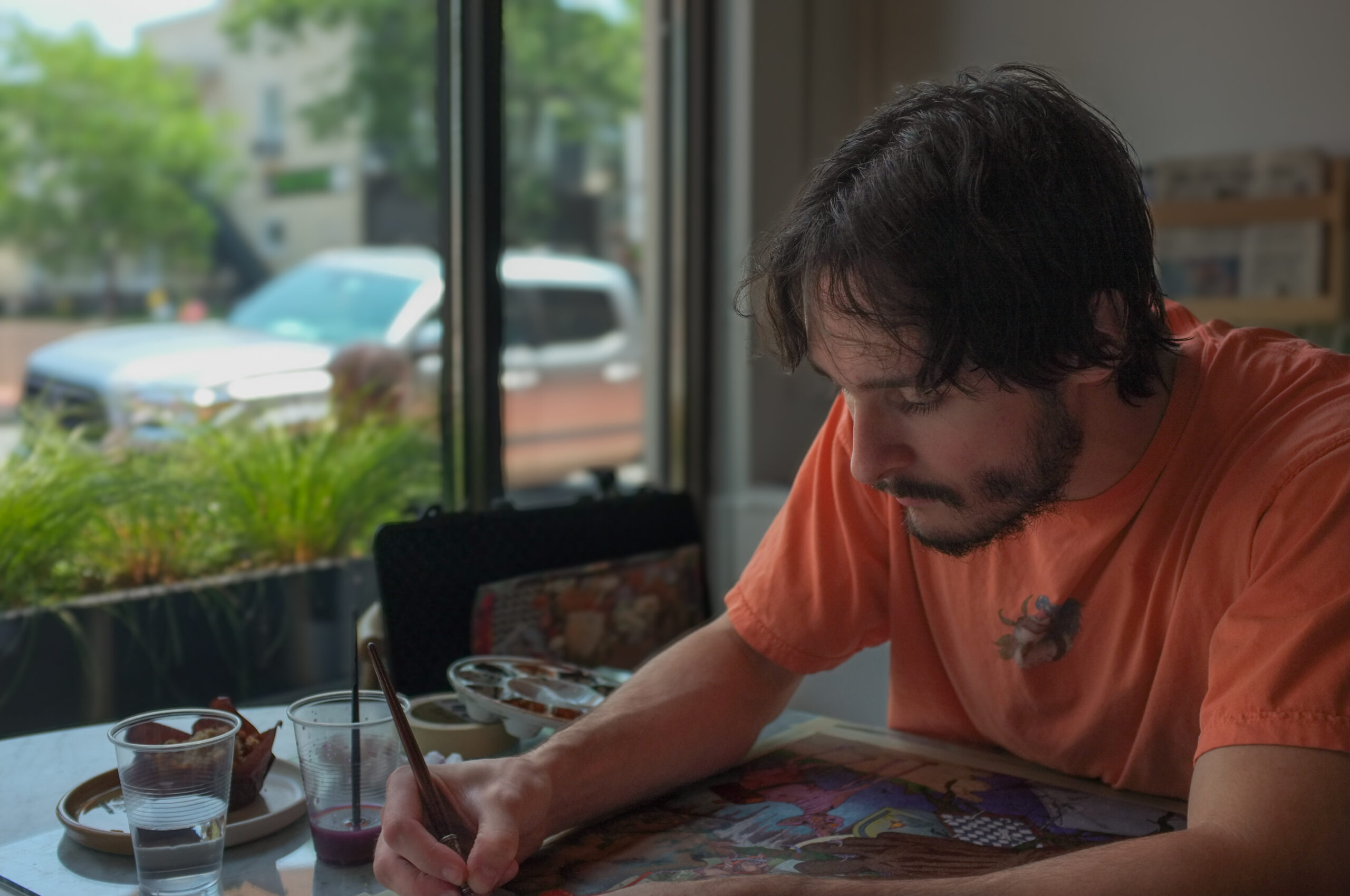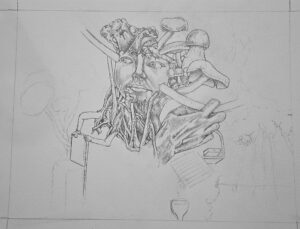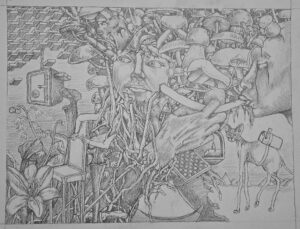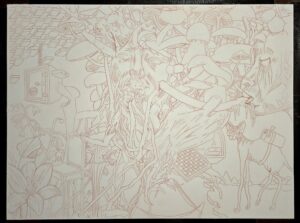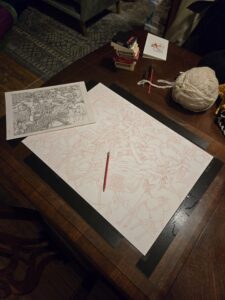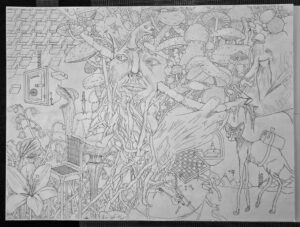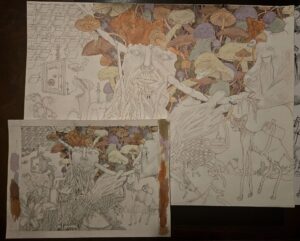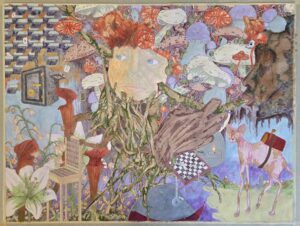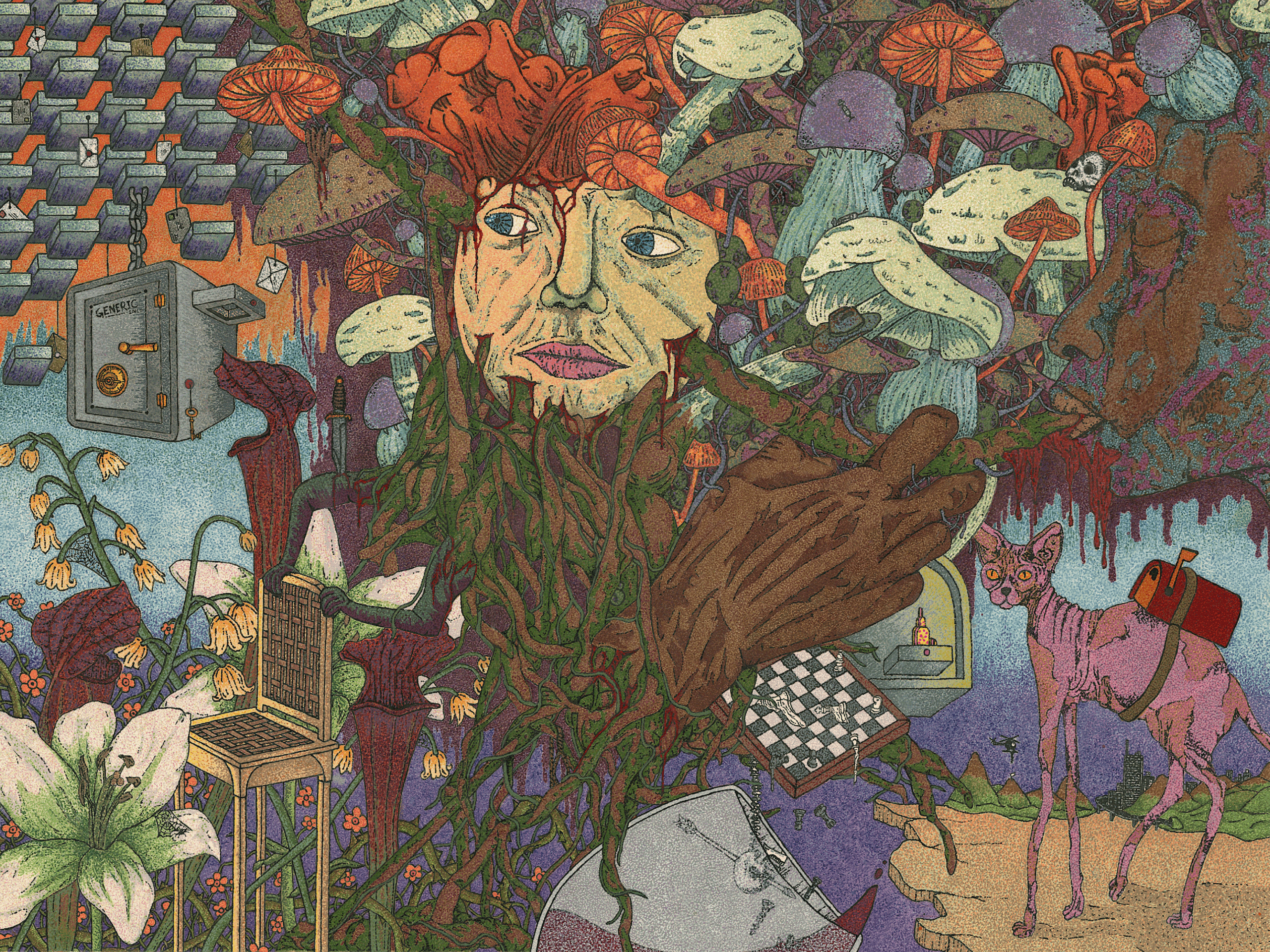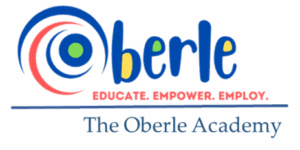It was a lesson in delayed gratification, said Kody Goudie, 22, of Fredericksburg.
The young artist recently celebrated finishing a new artwork that took him 426 hours to complete. “Kvava”, his largest completed piece to date, is a pointillism creation that oozes surrealism, whimsy and incredible detail.
The sketch began easily enough in December 2024, but Goudie found himself adding to the imagery over and over. But the real work began in February when he began bringing the piece with him to Anita’s Cafe in downtown Fredericksburg. He sat at a table and painstakingly began filling in the image with dots of shellac ink with a glass dip pen for two to six hours a day, three or four days a week. For months.
He began to draw some attention.
Cafe customers, staff and even the owner, Anita Crossfield, watched as his work grew and took on new life and dimensions.
“He’s poured so much heart and time into it, and while I don’t claim to know much about art, I find his work absolutely fascinating and that says something about how much it’s moved me,” said Crossfield.
The finished piece contains around 3.1 million dots—Goudie likes data so he has details for every square inch and every step of the birth of his creation.
“It’s my job to get data on people,” said Goudie, who is a personal trainer and ran a fine art printing company until recently. “I’m helping people track body weight percentages and fat loss and all of this stuff. For my normal day job, I’m used to data.”
But the dots weren’t part of the initial plan
The piece started as a 9-by-12-inch drawing. And then he decided he wanted it to be bigger. So he scanned the linework and traced the design onto an 18-by-24-inch piece of cotton rag paper. Then he began working with underpainting sections of the design.
“It was my first time underpainting, I took the small original and I would test the colors in the area. And then if I liked the colors, I would appropriate them onto the big piece,” he said. “And I kept doing that until I had the underpaint … but it’s kind of hideous. It’s quite bad. It’s not nearly as vivid and deep.”
So he added another layer of underpaint and began toying with the colors.
“I was working a little bit over at Agora (Downtown Coffee Shop) with it, too. They just don’t have as convenient a space as Anita’s and the windows here are just gorgeous. I ended up claiming that same table pretty much every day.”
Goudie has aphantasia, which means he cannot visualize an image in his head. But he can draw something by looking at it.
“There are no pictures in my head. But I have a good memory. And memory tends to translate into good transcribability. So if I was looking at an image, if I looked at my hand, I could just start drawing my hand.”
Working on his art at the coffee shop helped fuel his need to be around people. He would often ask other customers for their opinion on color or details in the picture. Just looking at the painting is like touring an historic home with a well-educated docent; there’s a story behind every element, every stroke, every dot of color.
Goudie describes himself as a “true extrovert”. He feeds off being around other people, he said. At home, he wouldn’t feel compelled to take on an art project of this scale.
“I would not do this if I was just by myself at home. I really enjoy the process of doing art. But having the busyness and the noise around me separates the work environment from home, where I’m trying to relax. And that keeps me efficacious. It keeps me doing my job.”
Working in a coffee shop comes with its own perils. There were spills and mistakes. And Goudie can point to every single “mishap” on the canvas.
“I used it as a demonstration because I think that it’s important to realize that mistakes can be incorporated into art, and I hate how artists are obsessive about the idea of perfecting their artwork,” he said. “They have this inherent imposter syndrome that goes into creating because they want to be as perfect as they possibly can and nobody understands how they progress through maturity. So, in my case, I actually dipped my finger into the ink and literally wiped it over the piece a couple times.”
It was a conversation with his girlfriend, a tattoo artist, that sparked the idea to cover the design with dots of color.
“She is an amazing artist. She has hyperphantasia and can draw whatever she wants. I draw things that are more chaotic. She is mind-boggled by what I create … And I made a joke to her after I finished the underpainting because she thought it was really cool. I said, ‘What if I just made this all dots? Like, every inch of it.’”
And so he did. He divided “Kvava” into sections and began diligently planning out the process of turning lines and colors into dots.
“I’d work on something like this area over here, I would just say I’m going to do the dots for that spot. And then it’s 45 minutes to an hour and a half, just dots in that area. It’s surprisingly mindless.”
Goudie says he is pleased by the way the piece turned out, with its “weird chaotic flow tone that I quite like.”
The finished piece is currently being framed, and Goudie and Crossfield are exploring ways to showcase the artwork so the public can see it, possibly even hosting an auction to sell it.
But that isn’t the point, said Goudie.
He stressed that it’s not a money-making product and he doesn’t care whether the print sells or not. What’s important to him is the impact the work has on people.
“If it sits here for a month and people look on the wall and read the little pamphlets that I’m going to make for it and say ‘holy s*it, 3.1 million dots, 197 days, 426 hours—that’s a lot of time investment. And he did that while poor and working towards his dreams within a specific job and also facilitating the growth of a company that didn’t pay him anything. I could probably do that.'”
“I think it’ll hopefully help other people continue to pursue delayed gratification projects. Sometimes you gotta wait. It’s okay to wait.”

